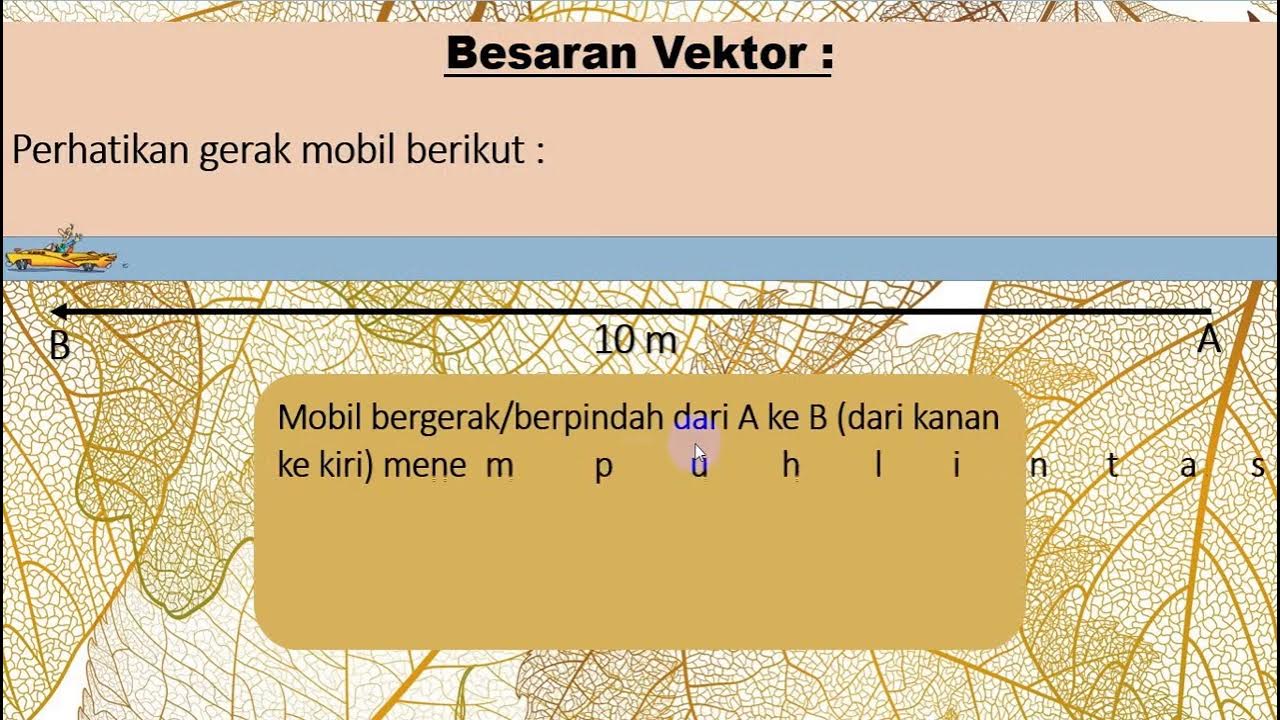GCSE Physics - The difference between Speed and Velocity & Distance and Displacement #51
Summary
TLDRThis video script delves into the concepts of speed and velocity, highlighting the difference between scalar and vector quantities. Speed, a scalar, measures magnitude without direction, while velocity, a vector, includes both magnitude and direction. The script clarifies the distinction using examples like a train crossing a bridge, illustrating how to calculate both speed and velocity. It also touches on average speed/velocity and provides real-life speed examples for various modes of transport and natural phenomena like sound and wind.
Takeaways
- 📚 Speed and velocity are fundamental concepts in physics, with speed being a scalar quantity and velocity being a vector quantity.
- 🔢 Speed is the magnitude of motion, measured in units like meters per second, and does not include direction.
- 🧭 Velocity includes both magnitude and direction, making it a vector quantity, such as '55 meters per second east'.
- 🤹♂️ It's common to confuse speed and velocity, especially in exams, so it's crucial to understand the difference.
- 📏 Distance, like speed, is a scalar quantity that measures the total path length traveled, regardless of direction.
- 🛤️ Displacement is a vector quantity that considers both the magnitude and direction of the movement from the starting point.
- 🚂 The example of a train crossing a bridge illustrates the calculation of speed as distance divided by time.
- 🚀 If the train's direction is known, the same calculation can be used to determine velocity, but with displacement replacing distance.
- 🔄 The formulas for speed and velocity can be confusing due to the use of the letter 's' for different meanings.
- 🔄 Average speed or velocity is calculated by dividing the total distance or displacement by the total time of travel.
- 🚶♂️ Real-life speeds vary widely, from walking at 1.5 m/s to planes exceeding 250 m/s, depending on the mode of transport and conditions.
- 🌬 The speed of sound and wind also varies depending on the medium and environmental factors.
Q & A
What is the difference between speed and velocity?
-Speed is a scalar quantity that only conveys magnitude, such as how fast an object is moving without considering direction. Velocity, on the other hand, is a vector quantity that includes both magnitude and direction, indicating not only how fast but also the direction of an object's movement.
Why is it important to distinguish between speed and velocity?
-It is important to distinguish between speed and velocity because they convey different information about motion. Speed only tells you how fast an object is moving, while velocity provides both the rate and direction of the movement, which is crucial for understanding motion in a more detailed way.
Can you give an example of a scalar quantity?
-An example of a scalar quantity is distance, which only has magnitude and no direction. It represents the total path length traveled by an object, regardless of the direction taken.
What is the formula for calculating speed?
-The formula for calculating speed is the distance traveled divided by the time taken to travel that distance, expressed as \( \text{Speed} = \frac{\text{Distance}}{\text{Time}} \).
How is velocity calculated if you know the displacement and time?
-Velocity is calculated by dividing the displacement by the time taken, similar to speed, but displacement includes direction. The formula is \( \text{Velocity} = \frac{\text{Displacement}}{\text{Time}} \), and the units would include the direction, such as meters per second east.
What is the difference between distance and displacement?
-Distance is a scalar quantity that measures the total path length traveled by an object, while displacement is a vector quantity that measures the shortest path from the starting point to the ending point, including direction.
Why might the symbol 's' represent different things in the formulas for velocity and speed?
-In the formula for velocity, 's' represents displacement, which includes direction. In the speed equation, 's' stands for speed, which is a scalar quantity. The symbol 'd' in both formulas represents distance, which is a scalar.
What is the average speed or average velocity?
-The average speed or average velocity is calculated by dividing the total distance or displacement traveled by the total time taken for the journey, regardless of whether the object moved at a constant speed.
Can you provide some real-life examples of speeds in meters per second?
-In meters per second, people walk at about 1.5 m/s, run at around 3 m/s, and cycle about 6 m/s. A car on the main road might travel around 25 m/s, a fast train could travel 55 m/s, and planes can exceed 250 m/s.
How does the speed of sound waves change when they travel through different mediums?
-The speed of sound waves changes when they travel through different mediums. In air, they travel at approximately 330 meters per second, but this speed can vary when they pass through other mediums like water due to changes in density and elasticity.
What factors can affect the speed of wind?
-The speed of wind, which is the natural movement of air, can be affected by factors such as temperature, atmospheric pressure, and structures like buildings or mountains.
Outlines

此内容仅限付费用户访问。 请升级后访问。
立即升级Mindmap

此内容仅限付费用户访问。 请升级后访问。
立即升级Keywords

此内容仅限付费用户访问。 请升级后访问。
立即升级Highlights

此内容仅限付费用户访问。 请升级后访问。
立即升级Transcripts

此内容仅限付费用户访问。 请升级后访问。
立即升级浏览更多相关视频

Kelajuan dan kecepatan Berbeda

Motion Class 9 One Shot in 10 mins | Best CBSE Class 9 Physics Revision Strategy | Abhishek Sir

BAB 4 : GERAK DAN GAYA | Part 1 : GERAK BENDA | IPA SMP Kelas 7 Kurikulum Merdeka

Kurikulum Merdeka Rangkuman Materi IPA Kelas 7 Bab 4 Gerak dan Gaya

Cinemática 04: Grandezas Vetoriais e Escalares

Besaran vektor dan besaran skalar (Fisika SMA/MA Sagufindo kls X smt 1 : Vektor)
5.0 / 5 (0 votes)
